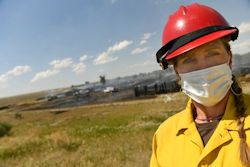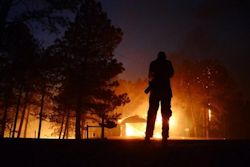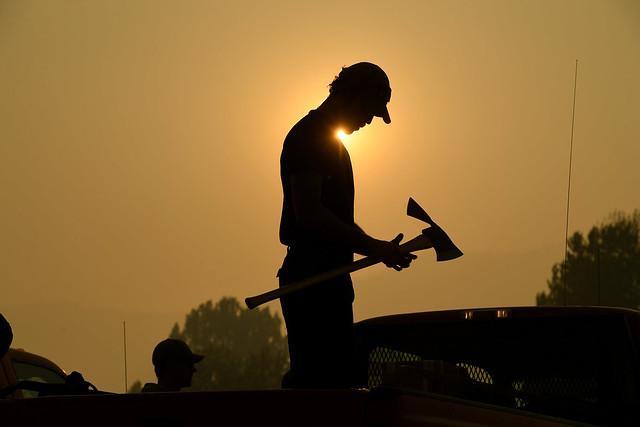SEJournal Online is the digital news magazine of the Society of Environmental Journalists. Learn more about SEJournal Online, including submission, subscription and advertising information.
EJ InSight: F/8, N95 and Be There — Wildfire Photojournalism in the Pandemic Era
By Helen H. Richardson
A common mantra shared by many photojournalists is the response attributed to famous street photographer Weegee when asked what was his secret for making great pictures: “F/8 and be there.”
 |
| Richardson wearing firefighting protective gear, including an N95 face mask for protection from COVID-19, as she covers the Bradbury Krebs Fire on June 30, 2020, in Byers, Colo. Photo by Helen H. Richardson, The Denver Post. Click to enlarge. |
Likewise, the greatest challenge to making good wildfire pictures is definitely getting there. But also, even more than usual in these days of coronavirus, it’s getting back — safely.
In Colorado, where I have worked as a photojournalist at The Denver Post for over 25 years, I have covered a lot of breaking news. That involves many hazards: protests, riots, snowstorms, floods, wildland fires. All present inherent dangers to yourself and your work as a news photographer.
So safety must be the top priority for journalists when covering breaking news, and especially wildland fires, which have become one of my specialties. And while there are many hazards associated with covering these events, it isn’t always the fire itself.
This year, on top of everything else, we are faced with staying safe in the midst of the COVID-19 pandemic. Who could have ever expected an unseen virus to bring so much fear and uncertainty to our world?
Only you can protect yourself
At the end of June, I covered a large brush fire about fifteen miles south of Denver. As I was working, I realized no one around me was wearing a mask. And I mean no one.
It’s very easy to fall into complacency, because this pandemic is invisible and it’s hard to be vigilant. It’s easy to think that since others are not wearing masks why should I? But this is groupthink. When covering breaking news, safety should be first, second and even third.
To stay safe to do your job, you need to take the responsibility to wear your N95 mask, even if others are not. And you must have the courage to ask people to back off if you feel they’re too close. You must be diligent about maintaining social distancing.
The only one who is going to
protect you from this virus is you.
Having covered the pandemic since it started in early March, I have come to the conclusion that the only one who is going to protect you from this virus is you. While your employer might be able to give you the necessary personal protective equipment to be safe, it is up to you to be diligent in using it.
The other major change brought on by the pandemic is how stories get reported.
Even before the presence of COVID-19, covering wildfires as a photojournalist was a very solitary practice. In 2012, The Denver Post photography staff numbered almost 30. Today we have only eight, with just five photographers.
So especially when it comes to wildfires, with fewer and fewer journalists out there, photographers really have to be reporters as well.
I’m the one on the ground doing my work at the scene of a fire, while the reporter, due to quarantining considerations, can cover the story by phone, often utilizing leads to people that I’ve provided.
I worked with one reporter recently who had just come out of his home for the first time in two and a half months.
Car as office and PPE
My car is essentially my workplace. There’s never any need to go to the office, since we use personal hotspots on our phones and can file our work from anywhere, as long as there’s cellular service.
But beyond being your workplace, your car is your ultimate piece of personal protective equipment when you’re covering wildfires. Because it’s what’s going to get you safely to and from where you have to be to get good pictures.
 |
| Richardson working late into the evening on the Black Forest Fire on June 12, 2013, near Colorado Springs, Colo. In the end, this fire burned 14,280 acres, destroyed 488 homes and claimed the lives of two people. Photo by Aaron Ontiveroz, The Denver Post. Click to enlarge. |
So you need to stock it, maintain it and care for it as conscientiously as firefighters treat their fire engines.
When fire season begins, I put my fire gear in the car. In my go bag is protective Nomex clothing, hardhat, headlamp, fire shelter, sturdy hiking boots, MREs (meals ready to eat) and plenty of water.
Stuffed in the side pockets are masks, hand sanitizer and Clorox wipes. I have a lot of extra masks so I can always offer them to others if needed, and even carry a separate water bottle just to clean my hands when I get back to my car.
Make sure you have an AC power inverter in your car. Always. Have a phone charger in your car. Always. And a full tank of gas, so you can always keep your computer, phone and camera batteries charged.
This all might sound obvious, but I have worked with many people who forgot to charge their phones and find themselves with a dead phone in the middle of a wildfire.
When shooting wildfires you want to make sure you have an array of lenses. I have everything from a wide angle, 20mm lens all the way up to a 400mm.
Typically the lenses you use most, especially in Colorado, are long lenses, because you are always farther away than you think or want to be.
Being prepared also means being in shape.
Often when covering wildfires you do a lot of hiking with your heavy gear. As with firefighters, good physical conditioning gives you more stamina and endurance for the long haul which covering fires can demand.
Being well prepared isn’t only about
having the right gear in your car.
It also is about knowing how to stay safe.
Being well prepared isn’t only about having the right gear in your car. It also is about knowing how to stay safe.
Beyond all the preparations, how well do you know what you’re getting yourself into? Do you understand fire weather and fire behavior?
Kent Porter, a staff photographer at the Santa Rosa Press Democrat in California and one of the best in the business, wrote recently in National Press Photographers Association’s magazine, “For photojournalists covering wildfires, it is a balance of caution, experience and persistence to succeed while still being safe.”
Breaking free of ‘media staging’ restrictions
Contrary to popular belief, having press credentials in Colorado means absolutely nothing. It gives you no access at all.
Most wildfires are overseen by local sheriff’s departments. They’re the ones that close roads, evacuate homeowners, manage traffic and basically keep the media out.
In my 20-plus years of covering wildfires, it’s only gotten worse. Even when we do gain access, most often we’re kept in “media staging” areas miles from the actual fire and rely on “media tours” to get anywhere near it.
By contrast, thanks to California state laws, journalists there have far greater access and the photography they produce is exceptional.
That’s why when a fire starts, it’s important to get to it as fast as you can. The first day of wildfires is always the most chaotic and typically the most active. Before fire crews have arrived, and law enforcement has had time to close every single possible route to a fire. And it’s often the time you’re able to make the best photos.
Covering wildfires in Colorado
definitely means pushing the boundaries.
In dealing with authorities, I have learned never to lie about anything. Don’t break laws. But covering wildfires in Colorado definitely means pushing the boundaries.
For instance, it’s important to find roads that will lead you close to the fire that haven’t been closed by law enforcement. Sometimes it entails hiking in, but you want to be careful not to get too far from your car or worse, get caught inside the fire itself.
It can be a tricky balance. In 2013, Hyoung Chang, a fellow Denver Post photographer, was covering a major fire complex in southern Colorado. Dressed in his fire PPE gear, he was photographing in a town that had been evacuated when a local sheriff’s deputy accused him of impersonating a firefighter and arrested him.
So it’s important to know the access laws for the state where you’re working. Also, getting to know public information officers on major fires can be helpful. Keep in frequent touch with them seeking access and be persistent.
Also in Colorado, authorities can’t force people to evacuate from private property. So if an owner permits you to work on their property, the authorities can’t kick you out. But on a public street, once they tell you to leave, they can arrest you if you don’t.
Maintain your ‘situational awareness’
Once you’ve arrived on a fire, don’t get so caught up in the action that you forget where you are and what’s happening around you. Don’t lose sight of your situational awareness.
It greatly helps to have taken the S-130 and S-190 firefighter training classes about wildland firefighting and fire behavior required of all firefighters before they can work on the fire lines. You learn basic knowledge about how fires work, and what to look out for in the weather, as well as how to avoid bad situations.
In short, you learn to take the same approach to wildfire photography that the fire crews learn to take to firefighting, i.e.:
- Always be aware of what’s happening all around you.
- Stay aware of changing weather conditions.
- Don’t put yourself in precarious situations needing rescue.
- Make sure you tell people where you are going.
- Don’t depend on cell service. You might lose it.
- Don’t get in the way of firefighters or first responders doing their jobs.
- Don’t break laws and get arrested.
- Know your limitations.
- Wear your mask.
I’m always proud of myself when I complete a breaking news assignment with nothing going wrong. Believe me, I have had many problems and made many mistakes through the years, and have learned from every one of them.
If you’ve successfully shot photos of the fire and made your deadline while staying safe, that to me is the mark of a good photojournalist.
Stay safe and more importantly, wear your mask until this pandemic is over.
[Editor’s Note: Also see Richardson’s case study with photographs of one particular major fire assignment where most of the challenges she cites were confronted … and surmounted.]
Helen H. Richardson is a staff photographer at The Denver Post. As a photojournalist, Richardson has covered large breaking news stories, including the Sept. 11 terrorist attacks on the World Trade Center and the Pentagon, the 2004-05 tsunami in Indonesia and Thailand, the death of Pope John Paul II in Rome, and the effects of AIDS and lack of water in African nations. In Colorado, she covers news and sports and specializes in wildfire coverage. She particularly enjoys stories that converge with her interests, which include rock and ice climbing, extreme sports, nature, animals and the environment.
* From the weekly news magazine SEJournal Online, Vol. 5, No. 28 Content from each new issue of SEJournal Online is available to the public via the SEJournal Online main page. Subscribe to the e-newsletter here. And see past issues of the SEJournal archived here.













 Advertisement
Advertisement 



